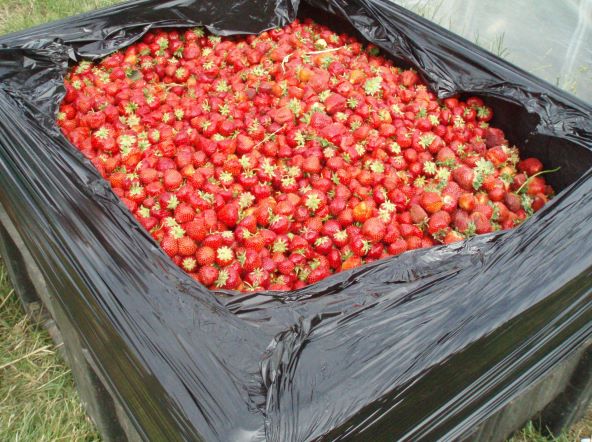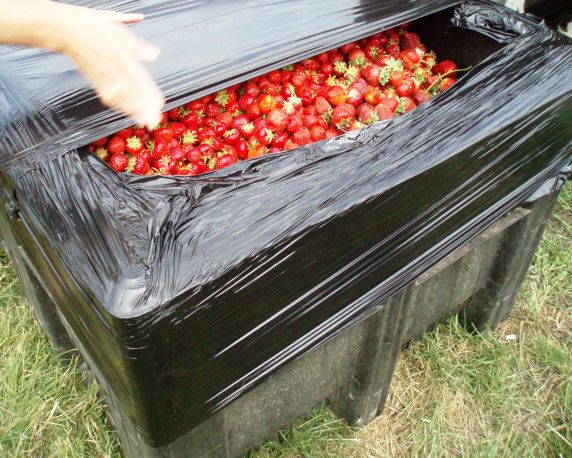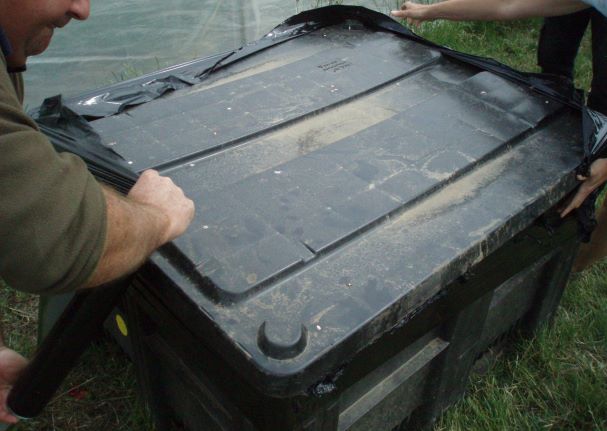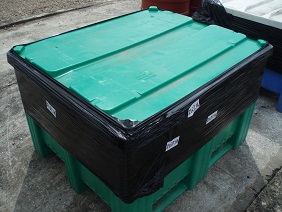Please click here to access the main AHDB website and other sectors.
- Home
- Knowledge library
- Collection and treatment of spotted wing drosophila fruit waste
Collection and treatment of spotted wing drosophila fruit waste
Spotted wing drosophila (SWD) is attracted to under-ripe, ripe and overripe fruits, so it is vitally important to remove any damaged, diseased and overripe fruits traditionally left in the field. It is also essential to remove old and waste fruit to prevent further SWD population build-up in a plantation.
This information was last updated in 2016.
Go back to the main page: Disposing of fruit waste affected by SWD
Collection of fruit waste
Waste fruit (old, damaged, diseased and misshapen) should be removed from the field, preferably at every pick.
It may be possible to mechanise the collection of fallen fruit in orchard crops such as plums and cherries.
Collection and disposal of fruit waste in polythene bin liners is impractical (see Figure 1), as the bags can be opened by wild animals and will eventually split or burst due to the fermentation of the fruit waste.
 NIAB
NIAB
Figure 1. Plastic bin liners are unsuitable for waste disposal
Plastic pallet bins
Waste fruit from the picking and packing operations can be collected in plastic pallet bins positioned next to the cropping or packing areas and transported to a suitable treatment area.
Alternatively, waste can be collected in covered bins that are frequently emptied, or in 30 to 50 litre sealable plastic vessels and kept at ambient temperature for up to two days or at 4°C for up to 10 days, before emptying into pallet bins.
Treatment in sealed bins
The most suitable plastic pallet bins have a capacity of between 500 and 670 litres (see Figure 2).
 NIAB
NIAB
Figure 2. Plastic pallet bins of between 500 and 670 litres are ideal for disposing of fruit waste.
Although 1,400 litre pallet bins or 200 litre plastic barrels with sealable lids can also be used, filling, emptying and handling these is more difficult.
Larger sealed plastic vessels with capacities up to 10 cubic metres have also been used successfully, although this requires an extraction hose for emptying the vessel and some water needs to be added to the waste to make it flow.
If using pallet bins, fruit waste should be filled to within 10cm of the top.
Shrink wrap
The top edge of the pallet bin is covered with a layer of polyethylene black stretch shrink wrap (about 50cm wide x 25micron thick).
 NIAB
NIAB
 NIAB
NIAB
 NIAB
NIAB
 NIAB
NIAB
Figure 3. Cover the edge of of the bin with polythene shrink wrap, then seal the top with the wrap. Add the lid and then seal with a further layer of shrink wrap.
In Research Project SF 145, ‘Understanding and developingmethods for managing spotted wing drosophila (SWD) in the UK: Vital research to maintain the viability of the UK fruit industry’, the procedure was tested with batches of soft and stone fruit waste to determine the length of time needed to eradicate SWD from the waste.
The oxygen and carbon dioxide concentrations in the headspace air in the bin were also recorded.
Drosophila species
During the testing, eggs, larvae and pupae of SWD or Drosophila melanogaster (the common UK fruit fly) or both, were introduced to the batches of pallets of fruit waste. The pallets were sealed for periods of between one hour and 13 days, before and after which samples of fruit waste were tested for the emergence of adult Drosophila species.
The tests were conducted both in warmer summer conditions (fruit waste at 18–25ºC) and in cooler conditions (fruit waste 14–16ºC).
Results
- Oxygen concentration in the headspace of the bins rapidly became depleted and was not detectable in any of the soft or stone fruit batches after six hours.
- In soft fruit at 18-25ºC, there was a corresponding increase in CO2 concentration that exceeded 20% v/v within six hours and reached 80% v/v within 24 hours.
- In some of the stone fruit batches at 14-16ºC, three days were required to reach 80% v/v CO2. Ambient air temperatures were 2-5°C lower than those recorded in the batches of waste.
- Adult D. melanogaster subsequently emerged from all untreated fruit waste samples, and from soft fruit samples taken from bins treated for up to 24 hours after the bins were sealed.
- A small proportion of adults (about 5% of the numbers emerging from untreated waste), emerged from stone fruit waste treated for three days.
- The results for emergence of SWD adults from treated fruit wastes were similar to those for D. melanogaster.
- No adult SWD emerged from soft fruit waste treated in sealed bins for two days at 18–25ºC, but two adult SWD emerged from stone fruit waste treated for two days at 14–16ºC, compared with 75 adults emerging from untreated waste.
- The higher risk of SWD survival in batches of stone fruit waste, particularly at lower temperatures, may be explained by the greater stability of the waste and slower increase in CO2 concentration than in soft fruit waste.
Useful links
Read more about spotted wing drosophila
Download the original 2016 factsheet version of this information
AHDB funded projects on SWD
Authors
Ralph Noble and Andreja Dobrovin-Pennington

